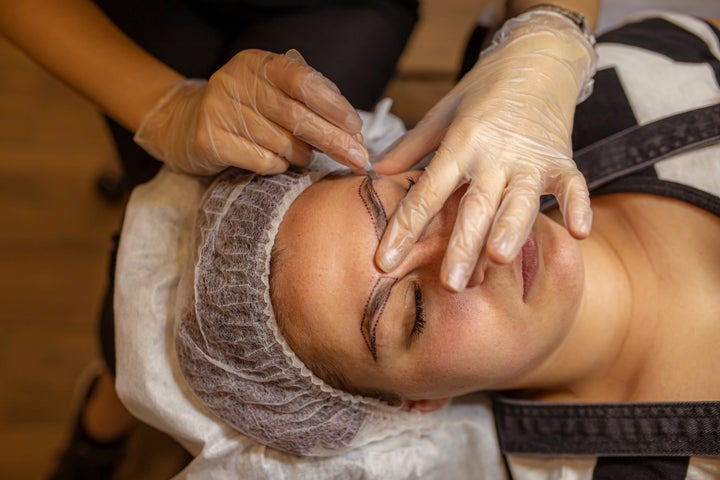Dermatologists explain what’s happening, and share how to treat and prevent it.
Eyebrows play several crucial roles. They frame your face and help you express emotions, like surprise, happiness and anger. They also help protect your eyes from moisture and light.
But as you get older, you may notice your eyebrows start to look a little wispy.
“It is true that most people will develop sparse eyebrows as they age,” New York-based board-certified dermatologist Dr. Lian Mack told HuffPost. “With age, the eyebrow hair follicles become senescent, often producing thinner, finer hairs.”
Around the time you reach your 40s, your levels of the hormones estrogen or testosterone start to decline. And with that comes hair thinning and hair loss.
Along with your hair’s natural reaction to aging, several other factors can cause your eyebrows to thin. “It may be related to age, over-plucking, treatments like chemotherapy, thyroid disease, hormonal fluctuations or an unbalanced diet,” Mack said.
Dermatologists say there are several ways to deal with thinning eyebrows, including at-home remedies and doctor’s office treatments. Here’s how to handle sparse eyebrows.
Why do your eyebrows get thinner as you age?
The natural aging process affects the hair-growth cycle, said Dr. Ife Rodney, a board-certified dermatologist. This can decrease eyebrow density and thickness.
“Aging can also cause a decrease in the production of melanin, the pigment responsible for hair color, resulting in lighter and sparser eyebrows,” Rodney said.
Hormonal changes, including a drop in estrogen and testosterone, can contribute to the problem. Nutrient deficiencies, including of vitamin A, vitamin B7 (biotin), zinc and iron, can slow hair growth. Thyroid disease may lead to eyebrow hair loss and skin conditions, like eczema or psoriasis, or the autoimmune disease alopecia areata could affect your eyebrows.
Genetics play a role, too. Mack said the number of hair follicles you have and your eyebrow thickness are genetically predetermined.
“If an individual is starting out with fewer eyebrow hairs, it may simply appear as if they are losing hairs more rapidly than someone who biologically has more hairs from birth and is of a similar age,” she explained.
And if you’re prone to genetic hair loss, you might be more likely to experience thinning eyebrows, Rodney said.
How to slow eyebrow thinning.
If you’ve already noticed your eyebrows are looking thin, dermatologists say there are a few things you can try to slow the process:
- Keep a healthy diet that’s rich in antioxidants, including a rainbow of fruits and vegetables.
- Take vitamin E, biotin and iron supplements to speed up hair growth.
- Avoid overplucking.
- Apply sunscreen to your eyebrows, as UV rays can damage sensitive hair follicles.
- Avoid using scrubs or other skin care and cosmetics with harsh chemicals and opt for all-natural products.
- Use a serum to encourage eyebrow growth (see more below).
- Talk to your dermatologist about the best course of action.
How to fake the appearance of fuller brows.
There are a couple of things you can do to address eyebrow thinning and make your eyebrows look a little fuller.
Use an eyebrow conditioner or serum.
Rodney said these products contain ingredients like peptides, biotin and panthenol, which promote hair growth and improve the appearance of your eyebrows. She recommends RevitaLash RevitaBrow Advanced Eyebrow Conditioner ($111) with biotin, green tea and ginseng.
Mack said one of her favorite eyebrow serums is RapidBrow Eyebrow Enhancing Serum ($39.99). “The formulation contains a number of peptides and conditioning ingredients to improve eyebrow density,” she said.
Try a pencil or gel to add volume.
Eyebrow pencils, gels and powders can fill in sparse brows and create the illusion of fullness, at least temporarily, Rodney said. She recommends the Charlotte Tilbury Brow Cheat Micro Precision Brow Pencil ($40.50).
“When choosing an eyebrow pencil or powder, select a shade that closely matches your natural eyebrow color for a more natural look,” she said.

Determine whether you should see a professional about thinning eyebrows.
Dermatologists can offer treatments for your thinning eyebrows, depending on the cause, Mack said.
“A board-certified dermatologist can diagnose and work up the underlying cause of your eyebrow thinning,” she added. “Once the diagnosis is confirmed, he or she can create a customized treatment to target the cause of your eyebrow thinning.”
Intralesional Kenalog injections, or tiny diluted steroid injections, can help reduce inflammation around the hair follicle, Mack said. This procedure is often used when eyebrow thinning is related to an underlying autoimmune issue.
Platelet-rich plasma (PRP) injections can address thinning related to natural aging. Mack said this involves drawing a patient’s blood, spinning it down in a centrifuge, and then isolating the PRP, which is injected into the skin to revitalize hair follicles.
Dermatologists can also prescribe medication, like minoxidil (Rogaine), to stimulate hair growth and thickness, Rodney said. Other treatments include laser or light therapy or KeraFactor treatments.
“Remember that the effectiveness and availability of these treatments will vary from person and doctor,” Rodney noted.
Professionally trained microblading treatments are an option that purely fixes the aesthetics, not the actual thickness of your brows. The procedure is a semi-permanent cosmetic tattoo that involves using tiny needles to create hair-like lines along your eyebrows that give the appearance of fullness, Rodney said.
“Microblading is an effective tool for semi-permanent, natural-looking enhancement,” she said, adding that her own eyebrows are microbladed. “It’s safe when done by a qualified technician, effective and long-lasting.”
But microblading does come with a few risks, such as allergic reactions, scarring, infections and the potential that you just might not like the results, Rodney added. You’ll likely need touch-ups every couple of years, too, Mack said.
Credit: Source link